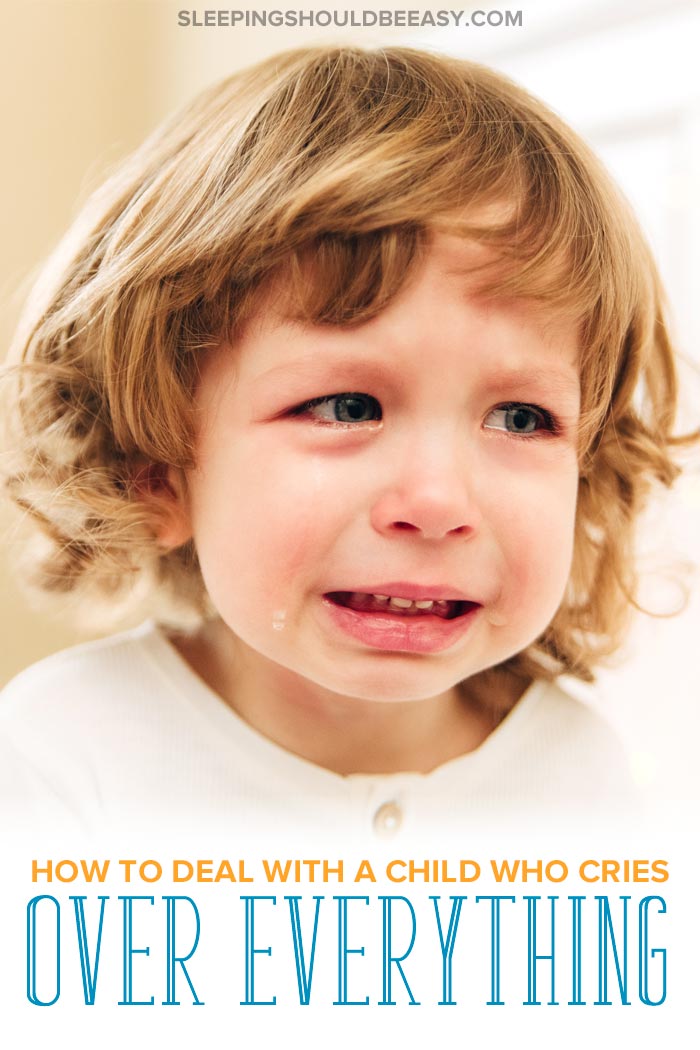How to Deal with a Child That Cries Over Everything
Wondering how to deal with a child that cries over everything? Discover 7 questions and phrases that will help her stop crying.

The blanket that wasn’t set exactly the way they wanted. The artwork that got bent along the corner. A sibling playing with the toy they wanted to play with. And let’s not forget the stuffed animal that wasn’t where they left it, the finished cookie, or the sandwich cut the wrong way.
These were just some of the things my kids have cried about. It seemed like anything that wasn’t exactly their way led to tears and tantrums.
Thankfully, I learned that we can help them cope with their big feelings, specifically by asking questions and phrasing our responses in certain ways.
Below, I list seven questions and phrases you can ask or tell your child when he’s crying over every little thing. It’s not just about telling her to “stop crying already.” Starting a conversation gives her the tools to handle his problems and see them in a new way:
Table of Contents

“I see you’re upset…”
Many of your child’s dilemmas—however petty they might seem—can truly feel devastating to her. Instead of brushing them, acknowledge them for being the real and even raw feelings she’s going through.
Saying “I see you’re upset because…” validates her feelings and gives words to them. Not only does she feel normal for feeling this way and now has a name to describe it, but now she can simply say, “I’m mad…” instead of throwing a fit.
After acknowledging her feelings, follow up with your expectations: “We don’t throw toys when we’re mad…” Offer suggestions of what she can do instead, from telling you she’s mad to walking away. You’re giving boundaries while validating how she feels.
Free resource: As frustrating as her behavior may be, a lot of it can be prevented simply by seeing things from her perspective. In The Power of Empathy, you’ll learn how empathy is the secret key that makes a huge difference in how we interact with our kids.
Imagine transforming your relationship with your child using just the lessons you’ll learn right here. Grab your PDF below—at no cost to you. You’ll also get my newsletters, which parents say they LOVE:
“Your emails resonate with me. I feel like we’re all in this together after I read your emails. Thanks for sharing!” -Brittani Roberson

“I don’t understand crying or whining.”
Your child may have gotten used to crying or whining as a normal way of speaking to you. Stop him from whining and establish new rules of communicating—namely, that you won’t engage with him unless he changes his tone.
Don’t deal with the issue—finding the teddy bear, for instance—until he can better communicate. The less attention he gets through crying and whining, the less he’ll continue that behavior. In fact, praise him for the times he calmly seeks your help, acknowledging that this is the proper way to speak.
“There’s a better way to say that.”
Your child’s problems and complaints wouldn’t be so bad if she didn’t say it in a grating, whining way. It’s not that you don’t want to help her find her lost teddy bear. It’s that she breaks down in an instant without even considering her options or other ways to get help.
But once you tell her that there’s a better way to phrase her problems, she ask for help in a better way. Model for her how to say exactly what she’s saying, in a better tone. Instead of, “My teddy bear is GONE!!!” she can say the same thing in a much calmer way: “My teddy bear is gone.”
“That’s not a reason to cry. That’s a reason to ask for help.”
As much as we want to validate our kids and their emotions, we also want them to see that not everything is worth crying about. One of the best ways to flip that assumption is to let your child know that he can simply ask for help.
Yes, he has a problem, but that doesn’t always mean that he needs to cry about it. Asking for help is one of the easiest ways to resolve the issue he’s having.
Involve him in the problem-solving process. Let’s say he cried because a crayon broke in half. Show him that he can always ask and tell you what he needs, and together, you can find a solution. Maybe that means coloring the rest of the flowers orange or coloring with the longer of the two broken pieces.
As always, talk to him when he’s calm, not when he’s in a fit. But now he knows that every dilemma isn’t the end of the world, and more importantly, he can come up with solutions to fix them.
“Do you want to talk about it?”
After validating your child’s feelings, you can also offer to talk about it. Once again, you’re refusing to hold a conversation with him when he’s crying and whining, but reassuring him that you’re here if he wants to talk.
Because there’s a big difference between crying and actually talking about the problem. He’ll see that you’re more than willing to help and talk with him about it once he’s calm, and you can use this opportunity to talk to him about his feelings.
You might say, “I can see you’re feeling upset about [fill in the blank]. Would you like to talk about what we can do?”
“What if everybody did that?”
Disclosure: This article contains affiliate links. As an Amazon Associate, I earn from qualifying purchases.
I’ve seen my son’s teacher ask this phrase of her students with great success. The question forces kids to imagine what would happen if everyone was allowed to behave the same way they did, and what that would look like.
Your child can see how ridiculous the household would be if everyone—including his parents—cried over every little thing that goes wrong. Even more, it makes him wonder why he’s the exception.
You might even check out the book What If Everybody Did That? by Ellen Javernick. Talk about how chaotic his environment would be if everyone made poor choices.
In fact, reading children’s books about feelings is one of the best ways to start a conversation about how he reacts to his problems. He can see he’s not alone and can model his choices on the characters he reads about.
“Would you like a hug?”
Sometimes all kids need to calm down from crying is a warm hug. We can’t process anything logical or verbal when we’re in the middle of a meltdown, kids included. Don’t teach, talk, or reason with her when she’s not in the right frame of mind. Instead, rely on non-verbal communication.
A hug can be one of the best ways to show her that you’re still here, despite her tantrums. While you’re not willing to engage with her unreasonable demands and tears, you are here to help her calm down. She needs to know that you love her, even if you don’t love her behavior.
“It seems like you’re having a bad day,” you might start. “Would a hug make you feel better?” Hugging, facial expressions, and soft body language can be all it takes to soothe her back to calm.
As I say in my book, 31 Days to Better Parenting:
“Children are especially attuned to body language, more so than words or instructions. Sometimes we don’t even need to say anything at all. A hug, a touch on the arm, a rub on the back. Those can be enough to signal that it’s all right and we love them.”
Conclusion
Dealing with a child who cries over everything can make for a challenging day. Thankfully, you now have a few phrases and questions to stop yours from crying over everything. You can respond calmly—even if it’s over a bent piece of artwork or a sandwich cut the wrong way.
Frequently asked questions
Anxiety about big changes are often the triggers, from a new baby to moving to a new house. As overwhelming as these changes are for you, you can imagine how much harder they are for your child.
She also find comfort in you—while she’ll stay composed at school, she knows you won’t reject or abandon her at home. Sometimes, you simply face the end-of-day meltdowns, especially when she’s been behaving well at school all day. We all have less willpower as the day stretches, so she’s more likely to make poor choices stemming from built-up frustration.
And finally, she’s still learning how to cope with her big emotions. She hasn’t had many years of practicing how to regulate strong feelings like sadness and disappointment the way you and I are better able to do.
Get more tips:
- What to Do when Your Child Cries at School Drop Off
- How to Stop Your Child from Crying at School
- What to Do When Your Toddler Is Hysterical at Bedtime
- If Your 3 Year Old Tantrums Every Day, Try These Methods
- How to Help Your Child Adjust to a New Baby
Don’t forget: Join my newsletter and grab The Power of Empathy below—at no cost to you:





